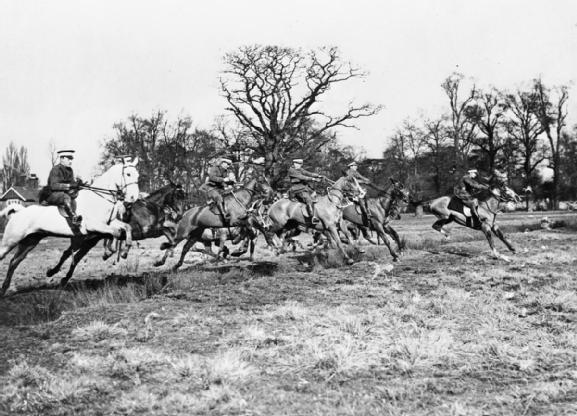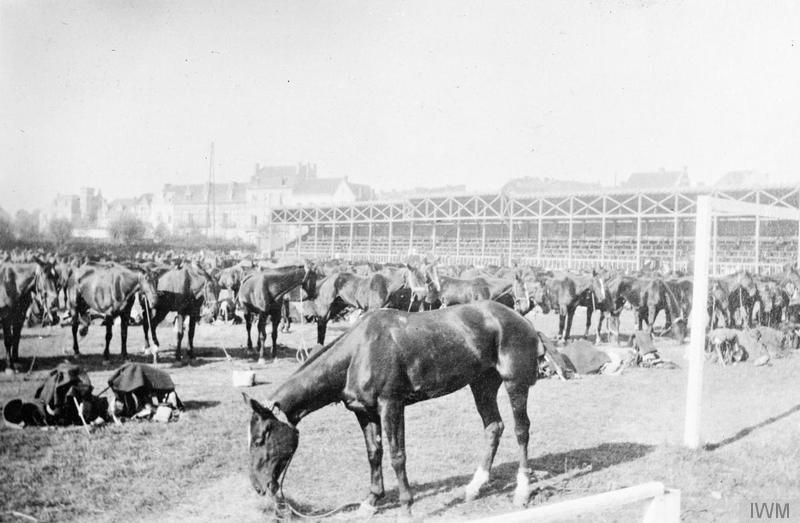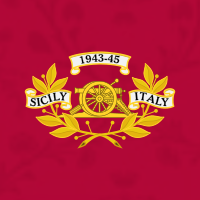|
Second Line Yeomanry Regiments Of The British Army
Yeomanry are part of the reserve for the British Army. At the start of First World War there were fifty-four yeomanry regiments in the British Army. Soon after the declaration of war, it was decided to increase the number of these volunteer mounted regiments. The new regiments were mirror formations of the existing first line regiments, with the same name and served initially in the same brigades. However they were all classed as second line units. The first line regiments, were numbered the 1/1st while the second line became the 2/1st (regimental name) or in cases where there were more regiments with the same name, or already numbered, the 2/2nd or 2/3rd. Territorial Force mounted brigades were known by their district name until August 1915, when they became numbered. For most of their existence the second line regiments and brigades were used as a coastal defence force. Most of the second line regiments were converted to cyclist battalions in 1916, and never served in a recognis ... [...More Info...] [...Related Items...] OR: [Wikipedia] [Google] [Baidu] |
Yeomanry Training First World War
Yeomanry is a designation used by a number of units or sub-units of the British Army Reserve, descended from volunteer cavalry regiments. Today, Yeomanry units serve in a variety of different military roles. History Origins In the 1790s, following the French Revolution and the rise of Napoleon Bonaparte, the perceived threat of invasion of the Kingdom of Great Britain was high. To improve the country's defences, Volunteer regiments were raised in many counties from yeomen. While the word "yeoman" in normal use meant a small farmer who owned his land, Yeomanry officers were drawn from the nobility or the landed gentry, and many of the men were the officers' tenants or had other forms of obligation to the officers. At its formation, the force was referred to as the Yeomanry Cavalry. Members of the yeomanry were not obliged to serve overseas without their individual consent. Early 19th century During the first half of the nineteenth century, Yeomanry Regiments were used exte ... [...More Info...] [...Related Items...] OR: [Wikipedia] [Google] [Baidu] |
2/1st Staffordshire Yeomanry
The Staffordshire Yeomanry (Queen's Own Royal Regiment) was a unit of the British Army. Raised in 1794 following Prime Minister William Pitt's order to raise volunteer bodies of men to defend Great Britain from foreign invasion, the Staffordshire Yeomanry began as a volunteer cavalry regiment. It first served overseas at the time of the Second Boer War. Following distinguished action in Egypt and Palestine in the First World War, it developed with the deployment of artillery and tanks. The Staffordshire Yeomanry became part of the Mercian Yeomanry in 1971 (renamed the Queen's Own Mercian Yeomanry in 1973) with one of the squadrons being designated B (Staffordshire Yeomanry) Squadron. History Formation and early history The regiment was formed on 4 July 1794 with commanding officer being Colonel George, ''Earl'' Gower. The regiment was divided into Troops associated with the Staffordshire towns of Newcastle-under-Lyme, Stafford, Lichfield, Leek and Walsall. The uniform of the ... [...More Info...] [...Related Items...] OR: [Wikipedia] [Google] [Baidu] |
2/1st Northumberland Hussars
The Northumberland Hussars was a Yeomanry regiment of the British Army, transferred to the Royal Artillery for the duration of the Second World War. It was disbanded as an independent Territorial Army unit in 1967, a time when the strength of the Territorial Army was greatly reduced. The regiment's name lives on in the title of the command and support squadron of the Queen's Own Yeomanry (QOY), a Formation Reconnaissance Regiment based in Newcastle upon Tyne. History Formation and early history In 1794, King George III was on the throne, William Pitt the Younger was Prime Minister of Great Britain and, across the Channel, Britain was faced by a French nation that had recently guillotined its King and possessed a revolutionary army numbering half a million men. The Prime Minister proposed that the Counties form a force of Volunteer Yeoman Cavalry that could be called upon by the King to defend the country against invasion or by the Lord Lieutenant to subdue any civil disorder ... [...More Info...] [...Related Items...] OR: [Wikipedia] [Google] [Baidu] |
2/1st Lanarkshire Yeomanry
The Lanarkshire Yeomanry was a yeomanry regiment of the British Army, first raised in 1819, which served as a dismounted infantry regiment in the First World War and provided two field artillery regiments in the Second World War, before being amalgamated into The Queen's Own Lowland Yeomanry in 1956. Its lineage was revived by B (Lanarkshire and Queen's Own Royal Glasgow Yeomanry) Squadron, the Scottish Yeomanry in 1992 until that unit was disbanded in 1999. History Formation and early history The units which would become the regiment were first raised in 1819, as independent troops of yeomanry around Lanarkshire. The five existing troops were regimented in 1848 as the Upper Ward and Airdrie Corps of Lanarkshire Yeomanry Cavalry, later retitled as the Lanarkshire Regiment of Yeomanry Cavalry. Second Boer War The Yeomanry was not intended to serve overseas, but due to the string of defeats during Black Week in December 1899, the British government realized they were going to nee ... [...More Info...] [...Related Items...] OR: [Wikipedia] [Google] [Baidu] |
21st Mounted Brigade
The 21st Mounted Brigade previously known as the 2/1st Western Mounted Brigade was a 2nd Line yeomanry brigade of the British Army during the First World War. In July 1916 it was converted to a cyclist formation as 14th Cyclist Brigade and in October 1916 was redesignated as 10th Cyclist Brigade. It was still in existence, in Ireland, at the end of the war. Mounted Brigade In accordance with the Territorial and Reserve Forces Act 1907 (7 Edw.7, c.9) which brought the Territorial Force into being, the TF was intended to be a home defence force for service during wartime and members could not be compelled to serve outside the country. However, on the outbreak of war on 4 August 1914, many members volunteered for Imperial Service. Therefore, TF units were split in August and September 1914 into 1st Line (liable for overseas service) and 2nd Line (home service for those unable or unwilling to serve overseas) units. Later, a 3rd Line was formed to act as a reserve, providing train ... [...More Info...] [...Related Items...] OR: [Wikipedia] [Google] [Baidu] |
2/1st Duke Of Lancaster's Own Yeomanry
The Duke of Lancaster's Own Yeomanry (DLOY) was a yeomanry unit of the British Army from 1798 to 1992. Originally raised as part-time cavalry for home defence and internal security, the regiment sent mounted infantry to serve in the Second Boer War. During World War I it carried out mounted duties in Egypt and Palestine and on the Western Front. By 1917 the reserve units at home had become cyclists and the regiment serving on the Western Front joined an infantry battalion, seeing action at the Battle of Passchendaele, against the German Spring Offensive and in the final Allied Hundred Days Offensive. At the beginning of World War II the regiment gave up its horses and formed two regiments of medium artillery, which served in the Middle East, Italy and North West Europe. Postwar it became an armoured unit. Today its lineage is maintained by B (Duke of Lancaster's Own Yeomanry) Squadron, the Queen's Own Yeomanry. French Revolutionary and Napoleonic Wars After Britain was drawn in ... [...More Info...] [...Related Items...] OR: [Wikipedia] [Google] [Baidu] |
2/1st North Somerset Yeomanry
The North Somerset Yeomanry was a part-time cavalry regiment of the British Army from 1798 to 1967. It maintained order in Somerset in the days before organised police forces, and supplied volunteers to fight in the Second Boer War. It served on the Western Front in the First World War. At the outbreak of the Second World War, it continued to operate in the mounted role and then as a specialist signals unit. Postwar it joined the Royal Armoured Corps and later became infantry. Its lineage today is maintained by 93 (North Somerset Yeomanry) Squadron 39 (Skinners) Signal Regiment. French Revolutionary and Napoleonic Wars After Britain was drawn into the French Revolutionary Wars, the government of Prime Minister William Pitt the Younger proposed on 14 March 1794 that the counties should form Corps of Yeomanry Cavalry that could be called on by the King to defend the country against invasion or by the Lord Lieutenant to subdue any civil disorder within the county. A meeting of househ ... [...More Info...] [...Related Items...] OR: [Wikipedia] [Google] [Baidu] |
2/1st Leicestershire Yeomanry
The Leicestershire Yeomanry (Prince Albert's Own) was a yeomanry regiment of the British Army, first raised in 1794 and again in 1803, which provided cavalry and mounted infantry in the Second Boer War and the First World War and provided two field artillery regiments of the Royal Artillery in the Second World War, before being amalgamated with the Derbyshire Yeomanry to form the Leicestershire and Derbyshire (Prince Albert's Own) Yeomanry in 1957. The regiment's lineage is currently perpetuated by E (Leicestershire and Derbyshire Yeomanry) Squadron of the Royal Yeomanry. History Original formation and early history During the crisis of 1794, when there were grave fears of a French invasion, the government pressed for the formation of volunteer corps across the country, and in April 1794, letters were circulated to the Lords Lieutenant of each county instructing them to raise regiments of yeomanry. In Leicestershire, a meeting was held at the Three Crowns Inn in Leicester on ... [...More Info...] [...Related Items...] OR: [Wikipedia] [Google] [Baidu] |
2/1st Queen's Own Yorkshire Dragoons
The Queen's Own Yorkshire Dragoons was a yeomanry regiment of the British Army in existence from 1794 to 1956. It was formed as a volunteer cavalry force in 1794 during the French Revolutionary Wars. Its volunteer companies played an active role with the Imperial Yeomanry in the Second Boer War, but opportunities for mounted action were much more restricted during the First World War and it was temporarily converted into a cycle unit. It remained a cavalry regiment throughout the interwar years, and was the last horsed unit of the British Army to see action, in the Syria–Lebanon Campaign of 1941, finally mechanising the following year. It served as motorised infantry in the North African and Italian campaigns of the Second World War. In 1956, it merged with the Yorkshire Hussars and the East Riding of Yorkshire Yeomanry to form the Queen's Own Yorkshire Yeomanry. Its lineage is continued today by A (Yorkshire Yeomanry) Squadron, the Queen's Own Yeomanry. French Revolutio ... [...More Info...] [...Related Items...] OR: [Wikipedia] [Google] [Baidu] |
2/1st Cheshire Yeomanry
The Cheshire Yeomanry was a yeomanry regiment that can trace its history back to 1797 when Sir John Leicester of Tabley raised a county regiment of light cavalry in response to the growing fears of invasion from Napoleonic France. Its lineage is maintained by C (Cheshire Yeomanry) Squadron, the Queen's Own Yeomanry. History Formation and early history The regiment was founded in 1797 when Sir John Leicester of Tabley raised a county regiment of light cavalry in response to the growing fears of invasion from Napoleonic France. In 1803, the Prince of Wales (later King George IV) gave his permission for the regiment to wear his triple feather crest, a badge that Cheshire Yeoman still wear today. Peterloo Massacre The Peterloo Massacre of 16 August 1819 was the result of a cavalry charge into the crowd at a public meeting at Saint Peters Field, in Manchester, England. Eleven people were killed and more than 400, including many women and children, injured. Local magistrates arran ... [...More Info...] [...Related Items...] OR: [Wikipedia] [Google] [Baidu] |
20th Mounted Brigade
The 20th Mounted Brigade previously known as the 2/1st Lowland Mounted Brigade was a 2nd Line yeomanry brigade of the British Army during the First World War. In July 1916 it was converted to a cyclist formation as 13th Cyclist Brigade and in November 1916 was redesignated as 9th Cyclist Brigade. It was still in existence, in Ireland, at the end of the war. Mounted Brigade In accordance with the Territorial and Reserve Forces Act 1907 (7 Edw.7, c.9) which brought the Territorial Force into being, the TF was intended to be a home defence force for service during wartime and members could not be compelled to serve outside the country. However, on the outbreak of war on 4 August 1914, many members volunteered for Imperial Service. Therefore, TF units were split in August and September 1914 into 1st Line (liable for overseas service) and 2nd Line (home service for those unable or unwilling to serve overseas) units. Later, a 3rd Line was formed to act as a reserve, providing train ... [...More Info...] [...Related Items...] OR: [Wikipedia] [Google] [Baidu] |
2/1st Ayrshire (Earl Of Carrick's Own) Yeomanry
The Ayrshire (Earl of Carrick's Own) Yeomanry was a Regiment of the British Yeomanry and is now an armoured Squadron of the Scottish and North Irish Yeomanry (SNIY), part of the British Army Reserve. It is the Lowlands of Scotland's only Royal Armoured Corps Unit and has an unbroken history stretching back to the 1790s. The squadron is part of 51st (Scottish) Brigade within the Army's Support Command. The Scottish and North Irish Yeomanry is the only yeomanry regiment that serves in the reconnaissance role, equipped with the Wolf Land Rover with Weapons Mount Installation Kit (WMIK) and with HMG (heavy machine gun 12.7mm L1A1) and GMPG (General purpose machine gun 7.62mm L7A2). On mobilisation, it provides squadrons to reinforce the regular Light Cavalry regiments. It has provided personnel to both Operation HERRICK in Afghanistan and Operation TELIC in Iraq, who have served with their regular counterparts in the Royal Armoured Corps and other arms and services. The A ... [...More Info...] [...Related Items...] OR: [Wikipedia] [Google] [Baidu] |





.jpg)


